I wrote the following article for the May 2011 issue of Trail Runner magazine, where it was published as “Running Through the Range of Light: Mountain Runners and Elite Roadies Explore Trails from Mammoth to Bishop.” Read on for an overview of the region, a Q&A with ultra trail runner Jeff Kozak, trail recommendations, and links for additional info.
UPDATE FOR 2014: I’m pleased to spread the news that Inside Trail is taking over race-directing for the May 17-18, 2014, Bishop High Sierra Ultra in the region described below. It will include a 100K, 50M, 50K and 20M course.
Hit the trails around the town of Mammoth Lakes, California, and you might get passed by some of America’s top distance runners. Olympians Deena Kastor, Meb Keflezighi and their teammates on the Mammoth Track Club spend roughly half their summer training on trails and dirt roads that ring multiple lakes, craters and rugged peaks in the area.
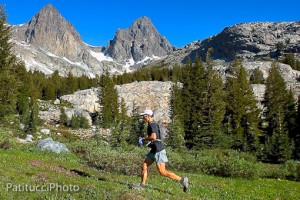
Trails from the Agnew Meadow trailhead near the town of Mammoth Lakes lead to these neighboring peaks: Mount Ritter (13,143 feet) and Banner Peak (12,936 feet). (Courtesy of Patitucci Photo.)
And when the white stuff blankets Mammoth for more than half the year, these pros head down toward the drier neighboring town of Bishop, about 40 miles south, and join a growing community of diehard trail runners who call the area home.
Yosemite National Park to the northwest and Mount Whitney to the south may be more famous, but the region in between offers some of the Golden State’s most diverse and underrated trail running terrain. Known as the Eastern Sierra, it crests like a great wave of chiseled granite across the high desert landscape of the Owens Valley.
The dull-brown valley floor spreads out in a windswept expanse, sprouting shrubs like a stubbly beard, until it hits the edge of Sierra Nevada range. The Sierra escarpment juts up some 10,000 feet with countless canyons between the peaks that hide forests and lakes. A parallel range, the Inyo-White Mountains, rims the valley’s east side.
In Bishop, trail runners get gear and guidance at Sage To Summit on Main Street. “Bishop is a fast-packing and mountain-running mecca,” says Howie Schwartz, who co-owns the shop with his wife Karen. “You have 14,000-foot peaks on both sides with a 4000-foot valley bottom, so year round you can run through different temperature zones and different ecosystems, from high desert sage to riparian forest, to sub-alpine aspen groves and alpine craggy ridgelines.”
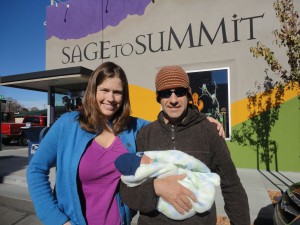
Karen and Howie Schwartz of Bishop’s Sage to Summit store–the place to go for gear and guides in the Eastern Sierra.
Numerous trails in the region cut west over the Sierra Crest and intersect with the John Muir Trail, which runs 211 miles from Mount Whitney to the Yosemite Valley. “There’s a lifetime’s worth of trails and dirt roads to explore here,” says Bishop resident and accomplished trail runner Jeff Kozak, who also works at Sage To Summit. Kozak has competed in countless ultras across California and holds the 50-mile course record (7:06) in the area’s signature trail ultra, Bishop High Sierra 100K, 50M, 50K and 20M.
Q&A with Jeff Kozak
Sarah: How would you describe the landscape of the Eastern Sierra?
Jeff: A single run here can take you from bone-dry desert upward through the pinyon-juniper zone, past timberline to an alpine playground dotted with deep blue glacial lakes and verdant green meadows, and on up until granite and sky collide with breathtaking, unobstructed views.
How would you describe the area’s trail running community—and is it really “a community,” or a bunch of hardcore runners doing their own thing?
There is definitely an element of hardcore trail runners doing their own thing, but a cohesive running community exists as well, albeit in a few distinct parts. The High Sierra Striders based out of Mammoth is one hub of activity, and Sage To Summit in Bishop is another. Each group’s activities have introduced a lot of positive energy. If it sometimes seems each is operating in its own world, I think it’s primarily due to the distance between the towns. We all support each other and the events we put on.
What’s the thing you do called “run & bag” all about?
“Run & bag” combines running and peak bagging into one outing. A lot of the peaks in the Sierra have fairly easy Class 2 to 3 route options, so there is a lot of opportunity for standing on a summit in your running shoes even if there is very little rock climber in your trail-running heart. Throw in a biking component for a “bike & run & bag” mountain cross-training adventure. One of my faves is to road bike from my place in Bishop at 4200 feet up to South Lake (22 miles, 5500-foot ascent), run to Bishop Pass at 12,000 feet (6 miles), and then scramble the final 2000 feet of vertical to Mt. Agassiz’s summit. It’s a great way to pull off a long training day without exclusively trashing your running muscles.
Why is the Bishop High Sierra ultra your favorite race?
My involvement with the race goes beyond toeing the line, which enhances its importance to me. Race weekend always has a family reunion feel that culminates with some quality post-race beer drinking and conversation. Though I prefer singletrack, watching the alpenglow of sunrise descend off the towering Sierra Crest while finding a rhythm on the long, relentless climb that defines the race, this minor detail of path seems insignificant in the face of the feeling the race evokes. I have always felt that the Sierra is my spiritual mountain range, where my soul runs as free as any gravity-bound soul can be, and every May this race confirms that feeling as strongly as any dawn-to-dusk solo run through the Sierra’s life-affirming granite womb.
Three Great Eastern Sierra Trails
Check out Sage to Summit’s fantastic Eastern Sierra Running Guide for directions to these and other trails:
Evolution Loop: This 100K loop, which follows the John Muir Trail through Evolution Basin, climbs 9800 feet and traverses some of the most visually stunning wilderness areas in the Eastern Sierra. Shorter out-and-back options include North Lake to Piute Pass (about five miles one way) or South Lake to Bishop Pass (about six miles one way). Snow may cover the passes until mid-summer.
Agnew Meadows to Thousand Island Lake: Agnew Meadows Campground is a starting point for some of the best trails around the High Sierra. It’s located west of Mammoth Lakes near the trailheads for the Pacific Crest and John Muir trails. A favorite loop is 12 miles past Thousand Island Lake. (See Deena Kastor’s story for a description on her variation of this run.) Trails open early summer through mid-autumn.
Lower Rock Creek: This relatively gentle, lower-elevation trail is a favorite wintertime destination, since much of the trail stays primarily snow-free. Eight miles of trail run along Rock Creek, starting about nine miles north of Bishop.
More info on where to run in the Eastern Sierra:
Dan and Janine Patitucci of Dolomite Sport, whom I thank for the use of their photos above, photographed and wrote a fabulous overview of the Sierra that focuses on the Mammoth and Bishop areas. Also, Leor Pantilat combined his ultra running and photography skills to produce a comprehensive Eastern Sierra guide called Trail Running in Sequoia and Kings Canyon National Parks for iRunFar.

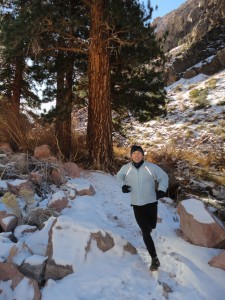
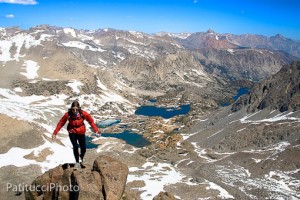
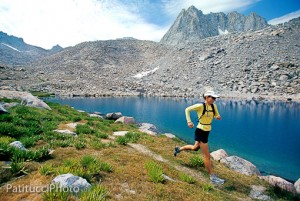
Wonderful article. I just got our permits for Mount Whitney in July, inspired by Jeff Kozak I think a “run & bag” up Mt. Agassiz will be in store as well.
I just compiled a list of some great runs to do on the Eastside in the winter. Since there isn’t much snow for skiing, the running is still great! http://sagetosummit.blogspot.com/2013/12/eastside-winter-running.html?spref=fb